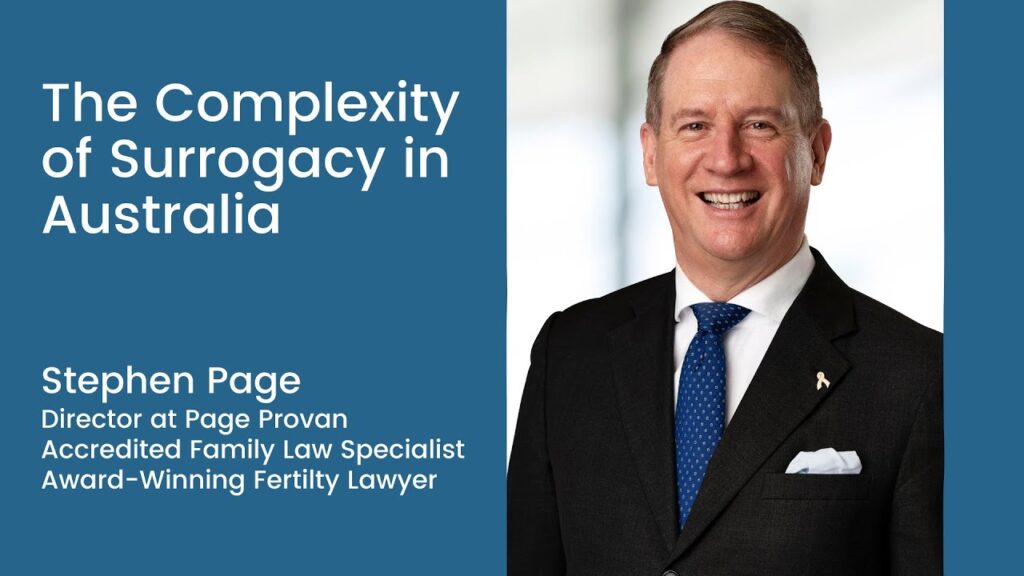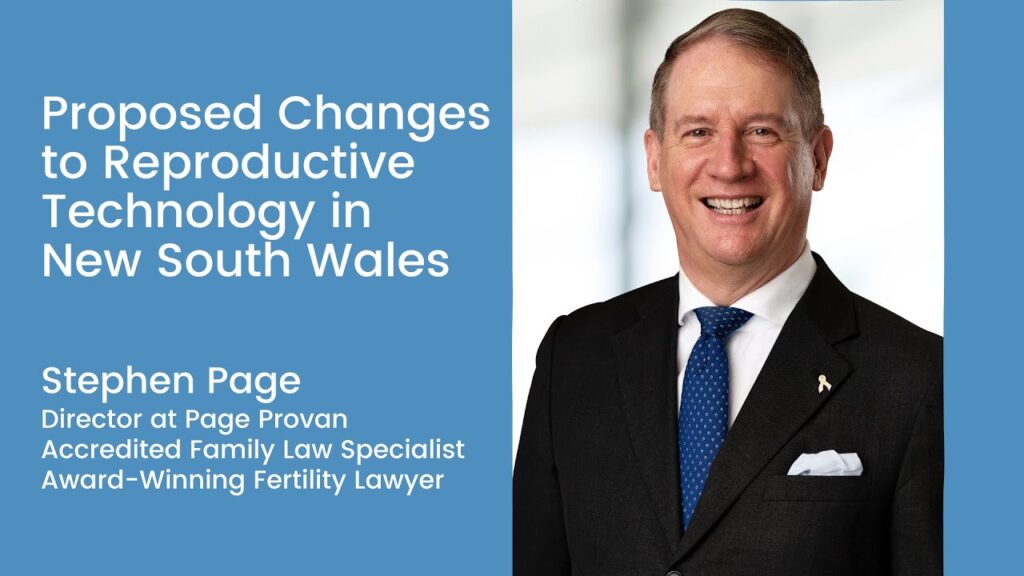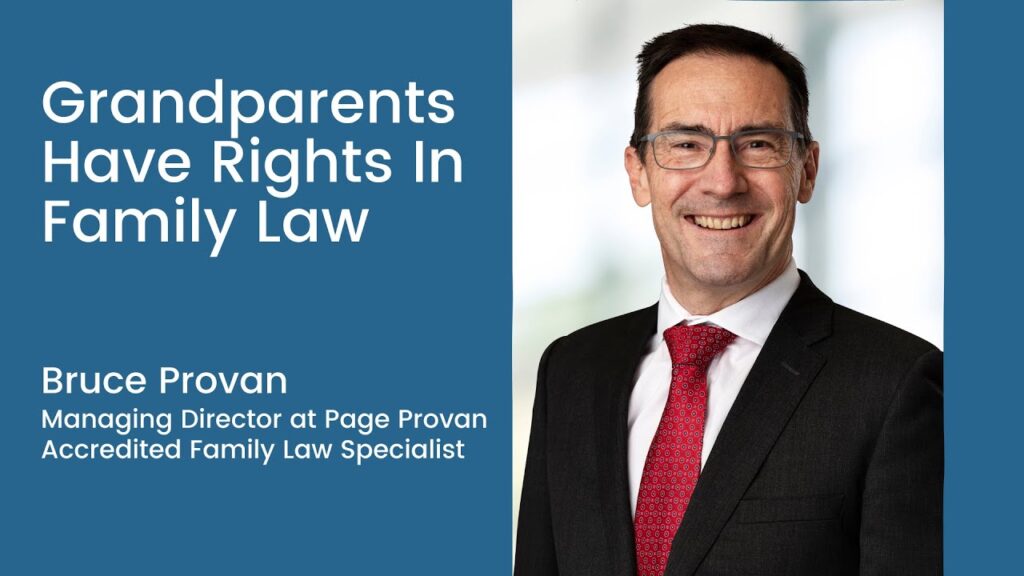Senate: Medicare should be available for surrogacy
The Senate has recommended that it be easier for LGBTQIA+ people to access medical care, including for assisted reproductive treatment. Hopefully, this will end the lottery of patients knowing whether or not they will be able to obtain Medicare benefits when they seek assisted reproductive treatment.
Currently 1 in 6 Australian couples of reproductive age have infertility issues.
The Senate has also recommended that the archaic exclusion of Medicare benefits for those accessing surrogacy be scrapped. It did so in the Senate inquiry into universal access to reproductive healthcare in Australia. Our director Stephen Page was privileged to give evidence.
Last year, Stephen wrote to Health Minister Mark Butler calling for the scrapping of the exclusion on Medicare benefits for surrogacy, which Stephen noted would cost the Government about $900,000 a year in a budget for assisted reproductive services that was about $1 billion. The response from the Government was that the dropping of the exclusion had been recommended by the Medicare benefits committee during the Morrison government, but that the Albanese Government would wait for the outcome of the Senate inquiry.
When Stephen gave evidence about this point, it was a surprise for the Senators to hear this evidence. They had not been told by the Minister that there was an expectation that they would be called upon to review this.
In separate comments, the Greens have recommended that the Government remove legal barriers to accessing IVF and altruistic surrogacy arrangements by:
- amending the definition of infertility to align with the International Committee Monitoring Assisted Reproductive Technologies’ definition of infertility; and
- deleting the word ‘particular’ from subsection 12(1) of the Prohibition of Human Cloning for Reproduction Act 2002.
Stephen drew both these matters to the attention of the Committee.
The traditional definition of infertility (regular unprotected sexual intercourse between a heterosexual couple over the course of 12 months which does not lead to pregnancy) has long been criticised for excluding individuals and LGBTQIA+ couples. In 2017 an international consensus was reached, excluding the World Health Organization, which concluded in effect that anyone who needs assisted reproductive treatment is infertile- thereby including LGBTQIA+ people and single intended parents.
A difficulty for LGBTQIA+ couples and single intended parents in seeking assisted reproductive services is the lottery of what approach each doctor takes. Some doctors remain fixed the traditional definition- which means no Medicare benefits. Others accept the international consensus definition.
The reason for that last recommendation by the Greens is that there is confusion about what that section means. Some officials have taken the view that intended parents cannot create embryos unless- at the time of the creation of the embryos- the particular woman in whom the embryos are to be implanted is able to be identified. Aside from obvious barriers to surrogacy, where the intended parents often do not have a particular surrogate in mind when their embryos are being created, this interpretation would prevent women facing an emergency hysterectomy, and removal of eggs for fertility preservation, being able to create embryos at that point. The penalty for a breach of the section is 15 years imprisonment.
Stephen’s evidence to the committee including his relating being told by a doctor that the point of the section was not about “particular” but about ”woman” – because the section is designed to ensure embryos were not implanted into biological men.
Individuals accessing assisted reproductive technologies
4.71 The Department submitted to the committee that approximately one in six couples of reproductive age experience fertility problems and may utilise assisted reproductive technologies (ART). These technologies have, historically, been provided in a private setting and subsidised through the Medicare Benefits Schedule and Pharmaceutical Benefits Scheme. They further explained that access to free services under state and territory government programs has generally been limited.
4.72 The MBS supports access to a range of relevant services involved in the clinical specialities of gynaecology (including ART and services involved in treating female and male infertility), obstetrics, participating midwifery, pathology, and diagnostic imaging.
4.73 From 1 July 2023, the Government will introduce a new payment to subsidise costs associated with the storage of eggs, sperm, and embryos for patients with cancer, and people at risk of passing on genetic diseases or conditions who have undergone MBS-funded preimplantation genetic testing.
4.74 The Government has also invested in a website, ‘Your IVF Success’, aimed at providing Australian couples with independent advice and information on fertility support services and IVF. Further, over the period between 2000 and 2021, the National Health and Medical Research Council has invested over $219 million towards research regarding fertility and infertility.
4.75 Although Medicare items related to ART services exist, Mr Stephen Page submitted that current practices have created unequal access to these Medicare rebates.
4.76 Section 4 of the Health Insurance Act 1973 (Health Insurance Act) stipulates that Medicare rebates can be claimed when ‘a person renders a professional service’. Section 3 of the Health Insurance Act explains that a professional service must be a clinically relevant service, which means: … a service rendered by a medical or dental practitioner or an optometrist that is generally accepted in the medical, dental or optometrical profession (as the case may be) as being necessary for the appropriate treatment of the patient to whom it is rendered.
4.77 Mr Page explained that the person receiving treatment must be considered infertile for the ART services to be deemed a clinically relevant service under the Health Insurance Act.
4.78 Mr Page outlined how the definition of infertility limited the cohorts of people who can access Medicare rebates for ARTs. Mr Page and Just Equal stated that infertility is traditionally defined as a disease of the male or female reproductive system, characterised by the failure to achieve a pregnancy after 12 months or more of regular unprotected sexual intercourse. This definition excludes a range of intended parents from claiming Medicare rebates when accessing ART, including, gay couples, single women, and lesbian couples. Mr Page explained that this is because these groups are biologically unable to conceive on their own or with their partner, as opposed to suffering from a physiological condition that renders them infertile.
4.79 Alex and Tom told the committee that the international consensus shifted in 2017 when the International Committee Monitoring Assisted Reproductive Technologies published a revised definition of infertility. They stated that this revised definition, as below, accounts for what is commonly referred to as ‘social infertility’. A disease characterized by the failure to establish a clinical pregnancy after 12 months of regular, unprotected sexual intercourse or due to an impairment of a person’s capacity to reproduce either as an individual or his/her partner.
4.80 Mr Page submitted that the dichotomy of medical infertility and social infertility means that clinics vary in their interpretation of infertility and how it relates to Medicare rebates. He stated that some doctors still use the traditional definition of infertility, whereas others use the social infertility definition. Consequently, same-sex couples face uncertain out-of-pocket costs associated with ART. As Mr Page told the committee:
You then have a lottery when you turn up at a doctor’s office: are you going to claim the Medicare rebate or not? […] you don’t know, when you turn up at that particular clinic and that particular doctor, whether you’ll get the rebate or not. It’s $5,000 a pop. Same sex couples and surrogacy arrangements
Same sex couples and surrogacy arrangements
4.81 Altruistic (non-commercial) surrogacy is legal in Australia, however, submitters flagged that the laws surrounding its process creates additional barriers for intended parents. Section 12 of the Prohibition of Human Cloning for Reproduction Act 2002 (Human Cloning Act) stipulates that it is an offence to intentionally create a human embryo outside of the body of a woman, unless the person’s intention in creating the embryo is to attempt to achieve pregnancy in a particular woman. This section is designed to address ethical concerns regarding the potential use of human embryos. Breaches of the section carry a penalty of up to 15 years imprisonment.
4.82 Mr Page submitted that this becomes difficult for intended parents, whose sole intention in creating an embryo is to conceive a child, when they have not yet formed a surrogacy arrangement. He gave evidence that some doctors accept and acknowledge the intended parents’ intentions’ and will interpret the legislation to mean that eventually the embryo will be implanted in a particular woman in the future. Alex and Tom told the committee that they had encountered this barrier when a clinic told them that they had to identify a particular woman at the time of embryo creation, as to do otherwise would be unlawful. They explained that: The delivery of this news … was a complete shock, as all we were trying to do was create a family. It was cruel, offensive, and traumatising to be delivered this news. For the rest of the day, Alex was hysterical. He could barely speak. We do not wish this fate upon anyone. We were being categorised as criminals and being likened to the sorts of people that create embryos for embryo farming purposes.
4.84 Submitters believe this hurdle is an additional layer of unequal access to reproductive healthcare for those whose only option is to conceive via surrogacy.
4.85 The committee heard from Dr Sarah Jefford that the inconsistency of state and territory laws relating to surrogacy further compound access issues, including for same sex couples.
Surrogacy and Medicare rebates
4.86 The committee also heard that once a surrogacy arrangement is in place, further barriers exist for intended parents. Surrogacy can cause immense financial strain as no Medicare rebates exist for ART processes associated with surrogacy, including the extraction of eggs, creation of embryos, or implantation of those embryos.
4.87 Mr Page told the committee that the Government has banned Medicare subsidies for surrogacy since 1990, which he considers to be a historical anomaly. He submitted that the exclusion of surrogacy from Medicare leaves intended parents to suffer greater out-of-pocket costs, where a non-subsidised round of in vitro fertilisation (IVF) costs approximately $8,000. However, he gave evidence that IVF, that is not for the purposes of surrogacy, would allow patients to claim a rebate of approximately $4,620.114
4.88 Just Equal cited an estimate that to remove the exclusion would cost less than $1million per year. Gynaecology MBS Items recommended that individuals undergoing an ART stimulated cycle as part of an altruistic egg donation or surrogacy arrangement should be provided MBS funding support.
Committee view
4.89 The committee acknowledges that large cohorts within Australia have been overlooked, underrepresented, or underfunded in sexual and reproductive health policy, service-delivery, and education.
4.90 The committee was concerned to hear that some sectors within the Australian community, as discussed in this chapter, encounter additional barriers to accessing appropriate, accessible, responsive and equitable reproductive health services and education.
4.91 The committee notes the following actions that could address this:
- Working with health practitioners to deliver further training and developing inclusive frameworks that ensure appropriate and adapted care.
- Increasing funding and resourcing for peer support networks and specialist organisations, as well as enhancing education.
- Improving access for a range of individuals who are currently excluded from receiving Medicare subsidised reproductive healthcare benefits.
Frameworks
4.97 The committee recognises that current practices and standards in the healthcare industry can be unaffirming and exclusionary for LGBTIQA+ people. Gendered language can deter LGBTIQA+ people from engaging healthcare providers, and assumptions regarding a patient’s anatomy and partner(s) can result in care that is neither appropriate nor adapted.
4.98 The committee acknowledges that the Australian Government has committed to developing and implementing a 10-year National Action Plan for the Health and Wellbeing of LGBTIQA+ people, in consultation with the LGBTIQA+ community. The Plan is expected to ‘guide how Australia addresses health disparities and make improvements across the health system.’
4.99 Therefore, the committee recognises the importance of practitioners utilising frameworks that support appropriate treatment of, and communication with, transgender and non-binary people.
4.100 The committee is also cognisant that the use of gendered language in reproductive healthcare settings can be exclusionary and therefore create barriers for LGBTIQA+ people to access this healthcare. The committee recommends that the Department of Health and Aged Care consider sexual and reproductive healthcare for LGBTIQA+ people in the context of the 10-year National Action Plan for the Health and Wellbeing of LGBTIQA+ people.
4.101 The committee recommends that the Department of Health and Aged Care consider sexual and reproductive healthcare for LGBTIQA+ people in the context of the 10-year National Action Plan for the Health and Wellbeing of LGBTIQA+ people.
Best practice guidelines
4.102 The committee acknowledges that current guidance on obtaining consent from individuals for medical or surgical procedures is general in nature and currently no specific guidance exists on obtaining informed consent from intersex people prior to medical interventions.
4.103 The committee also recognises that there is a lack of research on reproductive coercion and abuse. Further, the committee acknowledges that the limited research and understanding of reproductive coercion and abuse contributes to inadequate informational support for health practitioners in responding to this form of violence.
4.104 The committee recommends that the Australian Government consult with people with innate variations of sex characteristics regarding surgical interventions in the context of the 10-year National Action Plan on the Health and Wellbeing of LGBTIQA+.
In vitro fertilisation services
4.113 The committee recognises that the current medical definition of infertility is limited to a physiological condition. This definition effectively excludes LGBTIQA+ people from claiming Medicare rebates for IVF. As a result, LGBTIQA+ people can receive inconsistent advice from practitioners and incur greater out-of-pocket costs when engaging IVF services.
4.114 The committee recommends that the Australian Government explores the feasibility of Medicare rebates for in vitro fertilisation (IVF) services for cohorts not currently eligible for subsidised services.
Surrogacy-related services
4.115 The committee heard that surrogacy arrangements in Australia create further barriers for same-sex couples to start a family. The committee is aware that since ART services were subsidised through Medicare rebates in 1990, that surrogacy was explicitly excluded from Medicare claims.
4.116 The committee recommends that the Australian Government implement the recommendations of the Medicare Benefits Schedule Review regarding removal of the exclusion of in vitro fertilisation (IVF) services for altruistic surrogacy purposes












